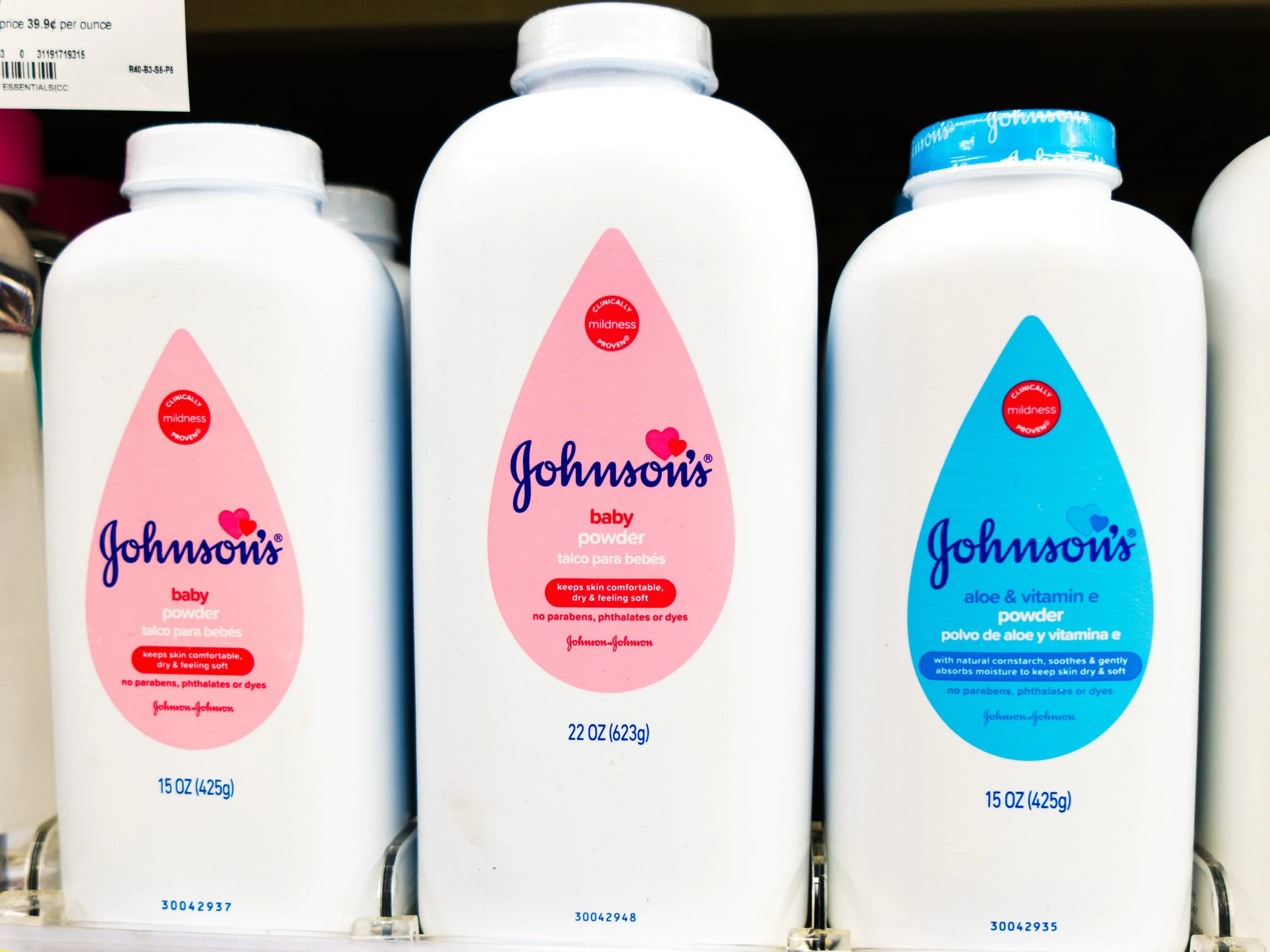In 1894, Johnson & Johnson first introduced a product made of crushed talc, calling it “baby powder.” For more than a century, people—especially women—used this product in their daily hygiene routine. As of May 2020, Johnson & Johnson discontinued their legacy product in the United States and Canada. This only comes after the company has been ordered to pay out billions of dollars in legal settlements over claims that the powder causes cancer.
Ongoing research and thousands of high-profile lawsuits against Johnson & Johnson and other manufacturers continue to bring the issue to light. J&J blames the discontinuation on the spread of misinformation about their product’s safety causing a lack of demand. However, there is now enough evidence to prove talc’s risk to human health and Johnson and Johnson’s awareness of this fact.
Talcum Powder, Asbestos and Ovarian Cancer
Johnson and Johnson invented the concept of baby powder as a marketing term for their powdered talc. Today, the powder has many other uses for cosmetics and hygiene.
What is Talcum Powder?
Talc is a clay mineral that is mined for its absorbent and odorless properties when ground into powder. It’s known for being among the softest minerals in existence and is effective for reducing friction on the skin. It can be found in many cosmetic products, from liquid makeup to lotions and deodorant. It’s sometimes used in small quantities as a moisture-wicking coat on medication tablets or gum.
Cosmetics that commonly contain talcum powder:
- Body powder
- Face powder
- Foundation
- Eyeshadow
- Blush
- Bronzer
- Lotions
- Face masks
Today, consumers who don’t want to risk exposure to the harmful components found in these products can research plenty of options for talc-free cosmetics and products.
Talcum Powder Products in Lawsuits
Other companies aside from J&J have been sued for their talcum powder products, such as Colgate-Palmolive (whose product has also been discontinued). Colgate-Palmolive has paid out dozens of undisclosed settlements for mesothelioma asbestos-in-talc cases. However, Johnson & Johnson’s products are significantly more popular, therefore many more lawsuits have been filed against their large-consumer products than other companies.
Johnson’s Baby Powder has been a staple in households for over a century. With the product marketed specifically for infant care and feminine hygiene, this product is at the heart of many talcum powder ovarian cancer lawsuits.
Shower-to-Shower Body Powder is a newer J&J product first made about 50 years ago. It was marketed for women with the slogan, “A sprinkle a day keeps the odor away, even when the company knew of the possible link between talc and cancer.
Talcum Powder and Asbestos
Talc is naturally formed among asbestos, meaning it is naturally contaminated. Companies are required to purify their talc, but tests have proven that products still contain asbestos.
Asbestos is a soft, natural compound made of flexible, needle-like fibers. It can be useful for its resistance to heat and electricity or to make materials like plastic or cement stronger. However, when it is inhaled or ingested, the fibers can become permanently trapped in the body.
Trapped asbestos can cause scarring, inflammation and eventual genetic damage. Mesothelioma is a rare and aggressive cancer almost exclusively caused by asbestos.
No amount of asbestos exposure is safe, but long-term exposure is significantly more dangerous. Researchers have concluded that, compared to the general public, talc miners are more likely to get lung cancer and non-cancer diseases.
Talcum Powder and Ovarian Cancer
When women use talcum powder as part of a feminine hygiene routine, the chance of being diagnosed with ovarian cancer is likely to increase. It is believed asbestos-talc particles are able to travel to the ovaries and cause inflammation resulting in ovarian cancer. Experts have stated that women who use talc have about a 20% higher risk for ovarian cancer than those who don’t.
A 2017 study discovered a “weak but statistically significant association between genital use of talc and ovarian cancer. Further, a 2018 study reported “a consistent association between perineal talc use and ovarian cancer.
These are the two most recent large-scale studies being used to support the statistical link between talc and cancer, but it is not just of recent interest.
Johnson and Johnson: A History of Hiding the Truth
Over the last 50 years, dozens of papers have been published on research looking for a link between talcum powder and various cancers. The first was published in 1971 by The Journal of Obsterics and Gynaecology of the British Common Wealth. This was a small study that found talc particles to be present in 75% of ovarian and cervical tumors removed from 13 different women.
Shortly after, according to litigation records, Johnson and Johnson J began a campaign to discredit research and block unfavorable findings from the public.
The Initial Lawsuit
Darlene Coker filed the first lawsuit against Johnson & Johnson in the 1990s after being diagnosed with mesothelioma, an indication of asbestos exposure. Her personal injury attorney honed in on talc as the suspect, knowing that it was often contaminated with asbestos during the mining process. As a mother of two, she had used baby powder on her infants and herself for most of her life. They eventually dropped the case due to an inability to prove the connection and J&J’s ability to avoid disclosing talc test results.
Essential Evidence is Exposed
Since then, the amounting number of lawsuits against J&J compelled the company to finally release thousands of internal documents and confidential reports. Reuter’s has extensively investigated these documents and found that the company failed to report to the Food and Drug Administration (FDA) at least three tests from 1972 to 1975 that had found asbestos in its talc. There was also evidence to prove that J&J was aware of asbestos contamination as early as the 1950s.
Reuter’s investigation found that the internal reports say there has never been, and never will be asbestos in J&J’s product. Reuter’s also notes that only a small fraction of J&J talc is actually tested. Worse, the company’s internal testing has always allowed trace amounts of asbestos to go undetected. The World Health Organization recognizes asbestos exposure as a zero-tolerance carcinogen; there is no safe level of exposure.
Johnson and Johnson’s Legal Obligation
Under product liability law, companies can be held liable for manufacturing defects AND marketing defects. Failure to adequately inform consumers of potential risks of using a product is considered a marketing defect. There is not yet a direct scientific link between talcum powder and cancer. This fact does not dispute the proven health risks of talcum powder. Johnson and Johnson should be held liable for failing to warn consumers of these risks.
Talcum Powder Lawsuit Settlements
The majority of talcum powder lawsuits have been filed by women who developed ovarian cancer, though victims of mesothelioma have also sued. In recent years, millions and billions of dollars have been awarded to such cases.
In July 2018, Johnson and Johnson was ordered to pay $4.7 billion to 22 women in Missouri who said asbestos found in the company’s talcum powder contributed to their ovarian cancer and failed to warn about the cancer risks. However, in July 2020, the court ruled to reduce the damages owed due to some of the women being from out of state. Still, it was proven that J&J disregarded the safety of consumers, motivated by profit. Johnson and Johnson must pay an astonishing $500 million in actual damages, and $1.62 billion in punitive damages.
In an (undisclosed) settlement in late 2019, Johnson and Johnson settled mid-trial for a woman who claimed asbestos-laced baby powder contributed to her cancer.
Ovarian Cancer Symptoms & Next Steps
There are no reliable screening tests for ovarian cancer. Women who suspect they have ovarian cancer will need to see a doctor to help monitor symptoms. Unfortunately, ovarian cancer symptoms often go undetected until the disease progresses into an advanced stage.
- Symptoms may include:
- Pain, pressure, or discomfort in the pelvic area
- Worsening pain in the back or lower abdomen
- Weight gain or loss
- Abnormal period cycles
- Vaginal bleeding or abnormal discharge
- Loss of appetite or difficulty eating
- Gas, nausea, or vomiting
- Consistent burning sensation in the throat and chest
- Frequent urination
Further, these symptoms are often commonly mistaken for those stemming from non-cancer illnesses. It is important to monitor the frequency and regularity of symptoms in order to know when they’re a cause for concern. Diagnosing ovarian cancer requires a physical exam, pelvic exam, lab tests and bloodwork, and an ultrasound or a biopsy.
Treatment depends on the location of the cancer and stage of development including surgery to remove cancerous tissue, the affected ovary, or sometimes the entire reproductive system. Chemotherapy may also be required if diagnosed with ovarian cancer.
It is essential to keep consistent records for medical and legal purposes. Building a strong claim requires extensive proof of the loss the victim sustained from her illness. Proper documentation will help with legal strategy and proving liability, while also increasing the likelihood of recovering the maximum damages.
Who is Eligible for an Ovarian Cancer Talcum Powder Lawsuit?
Talcum powder lawsuit claims are based on history of use of talcum powder, levels of exposure and the extent of harm or illness sustained. Successful lawsuits have been against the manufacturers and producers. Liable companies may have:
- Known of their talc-based products to be contaminated with asbestos and sold them anyway
- Failed to or inadequately tested talcum powder products for asbestos contamination
- Failed to adequately purify talcum powder products
Compensation for people suffering severe illnesses and cancers from exposure to contaminated talcum powder may be entitled to compensation for:
- Lost wages due to inability to work
- Past and future medical expenses for hospitalization, surgery, and visiting specialists
- Pain and suffering for both physical and emotional distress
- Permanent disability due to treatments such as invasive surgery and chemotherapy having long-term effects on the body
How Sobo & Sobo Can Help
The attorneys at Sobo and Sobo understand that an ovarian cancer diagnosis is a scary and vulnerable experience. If the diagnosis comes after exposure to talcum-based products, the victim may be eligible to file a claim against the company that jeopardized her health. The personal injury attorneys at Sobo and Sobo can pursue litigation that can lead to compensation for both economic and punitive damages.
Companies that do not properly test their products or warn consumers of risks should be held accountable. Don’t hesitate to contact us online or call 855-468-7626 for a free consultation.




